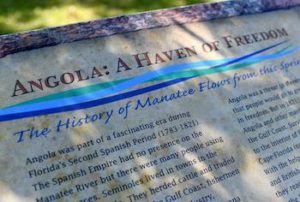
Angola plaque
*Angola, Florida, is celebrated on this date, c1812. This Black community of up to 750 Maroons lived in Florida from 1812 until it became a U.S. territory in 1821 when it was destroyed.
The location was near Manatee River in Bradenton, Florida, near Manatee Mineral Springs Park. The exact location is expansive, ranging from where the Braden River meets the Manatee River down to Sarasota Bay; archaeological research focuses on the Manatee Mineral Spring, a source of fresh water and later the location of the Village of Manatee two decades after the destruction of the maroon community. Archaeological evidence has been found and reported by Archaeologist Uzi Baram.
Her findings are on file with the Florida Division of Historical Resources of the Florida Department of State. Spanish Florida was a haven for escaped African slaves and Native Americans deprived of their traditional lands during the colonial era in the first decades of U.S. independence. The underground railroad ran south during this period. Escaped slaves were welcomed into Florida by Spain, who granted freedom to slaves who converted to Catholicism. Under heavy U.S. pressure, Spain rescinded this welcome, but the change had little practical effect. Occupied with the Napoleonic War and with many colonies in revolt, Spain had neither the resources nor the inclination to capture and return escaped slaves. Three autonomous black communities developed in Spanish Florida, though not simultaneously.
Fort Mose was the first and smallest autonomous Black community, but it was abandoned in 1763 after the Spanish cessation of Florida in the aftermath of the Seven Years' War. Neighboring St. Augustine heavily influenced Fort Mose. The second community was at Prospect Bluff (Fort Gadsden) on the Apalachicola River, but forces destroyed it under the command of General Andrew Jackson in 1816. Angola, farthest from the border of Georgia, was the last Black settlement to survive. According to historian Canter Brown, Jr., "Most maroon settlements were tiny because people needed to escape detection. Angola's 600 to 750 people was an incredible population back then, showing that these were capable people." He described it as "one of the most significant historical sites in Florida and perhaps the U.S."
None of these were settled as a group, as white colonies were; refugees gradually accumulated over many years until a community of several hundred existed. Some refugees from the Negro Fort calamity came to Angola, as did refugees from Lake Miccosukee Village and the Battle of Suwanee. When Andrew Jackson became Florida's de facto territorial governor in 1821, he "saw Angola's destruction as the first step in plans to rid the peninsula of runaways. Denied official authority, he dispatched Indian allies to do the work for him." "Acting in direct defiance of Secretary of War John C. Calhoun, Jackson's first order of business was to send his Creek allies on a search and destroy mission against Angola," which was "burned to the ground."
The raid resulted in "terror" all over Florida and all the blacks who could leave for the Bahamas. In July 2018, the first Back to Angola Festival was held at the Manatee Mineral Springs Park. Descendants of those who had escaped to the Bahamas attended.